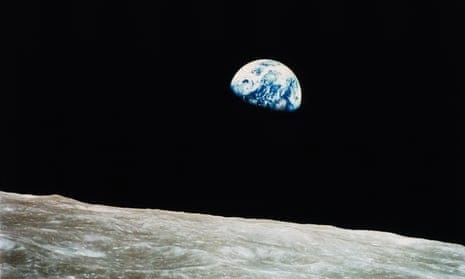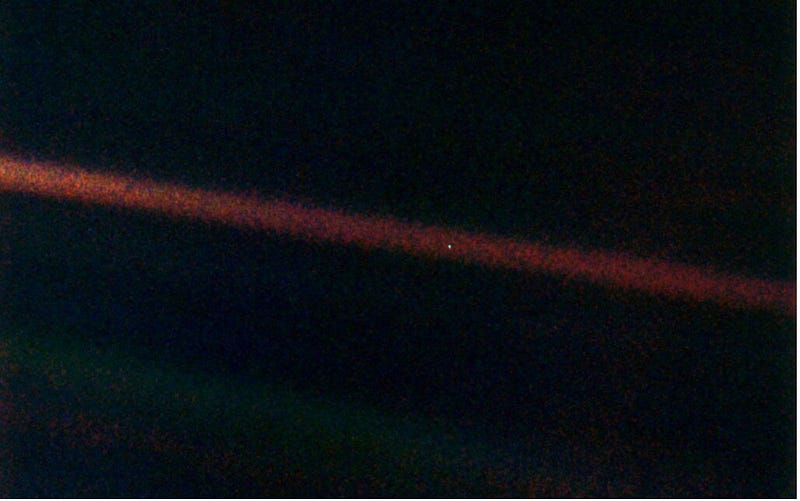Feeling Small: Finding Comfort in Our Cosmic Perspective
Written on
Chapter 1: The Comfort of Smallness
Experiencing a sense of insignificance can actually be liberating. In today’s fast-paced world, our challenges often seem overwhelming, but in reality, they are minor in the grand scheme of things. We are, indeed, quite small, and so are our troubles.

Photo credit: Dall-E 2
I have a deep admiration for the late astronomer Carl Sagan, whose insights often resonate with those seeking clarity. If you’re unfamiliar with the story behind the "Pale Blue Dot," it provides a soothing perspective amidst the chaos of modern life.
Sagan was not only a dedicated scientist who contributed significantly to our understanding of the universe but also a passionate advocate for science education. He played a pivotal role in numerous landmark space exploration initiatives.
One of his notable projects was Voyager 1, launched in 1977. Remarkably, it continues its journey beyond our solar system, having exited it in 2012, and we still receive limited data from this distant probe. Although its signals are faint, Voyager 1 persists.
Sagan's wisdom was profound. He believed that humanity needed to recognize our shared existence on this solitary planet. His lifelong mission was to convey this message, understanding that as our lives became increasingly hectic, we needed a way to remain grounded through wisdom and perspective.
During the late 1970s and early 1980s, Sagan was an optimistic humanist, advocating for unity during a time when global tensions threatened to tear us apart. He held that if people recognized our collective home—a lonely planet in the vast universe—we would be more inclined to embrace our better natures and move beyond conflict.
Sagan was captivated by the stunning images of Earthrise captured by the Apollo missions but believed that viewing our planet from a greater distance could offer even more insight.

Earth as captured by Apollo 8. Source: NASA
However, Sagan faced significant challenges in persuading NASA to take a photograph of Earth from afar. Throughout the early Voyager mission years, he tirelessly proposed this idea, convinced that such an image would provide valuable perspective.
His efforts were met with resistance for years, primarily because Voyager 1 was deemed a scientific instrument, and there was no compelling scientific rationale for redirecting its cameras back toward Earth. The technical difficulties of reorienting its instruments from such a vast distance added to the obstacles.
Nevertheless, Sagan persevered, stating:
"It seemed to me that another picture of the Earth, this one taken from a hundred thousand times farther away, might help in the continuing process of revealing to ourselves our true circumstance and condition." - Carl Sagan
Finally, in 1990, the image was captured by Voyager, and it was a groundbreaking moment.

Earth photographed from 3.7 billion miles away by Voyager 1. Source: NASA
When this photograph was released, Sagan prepared a remarkable speech to convey its significance. Here’s a brief excerpt that encapsulates the essence of our smallness:
“Consider again that dot [Earth]. That’s here. That’s home. That’s us. On it, everyone you love, everyone you know, every person who has ever lived out their lives is contained. The sum of our joys and sorrows, all religions, ideologies, and economic systems, every hero and coward, every creator and destroyer of civilization—each and every one of us—lives there, on a mote of dust suspended in a sunbeam.”
This notion brings me immense tranquility when I feel overwhelmed. If the light is just right, I can find a sunbeam in my home, observe the dust illuminated within it, and reflect on how our entire existence is but a speck in the vast universe.
Such thoughts often help me find rest when the demands of reality weigh heavily on me. In fact, research suggests that embracing our smallness in the universe can inspire kindness and generosity in people.
This perspective is essential. It becomes difficult to take minor grievances, like a low number of likes on social media or an irritating tweet, seriously when viewed through this lens.
We lack leaders who embody this perspective, and we need more of them. Sagan dedicated a decade to advocating for the "Pale Blue Dot" image, yet many failed to see its importance.
I would argue that it stands as one of the most poignant visual representations ever created by humanity. Those who wield power without recognizing this perspective appear utterly foolish when viewed from the vastness of space.
Personally, I find it hard to respect or take seriously those who lack this insight. This is perhaps the most frustrating aspect of the loud personalities that dominate our culture—they seem oblivious to the significance of the "Pale Blue Dot."
However, the comforting truth is that there are people in my life who do understand this perspective, and I believe that the ultimate purpose of life is to love them to the best of my ability.
Chapter 2: Embracing Perspective
The first video, "Phats & Small - Feel Good (Official Music Video)," emphasizes the joy of feeling good and the importance of maintaining a positive outlook.
The second video, "When you feel so small...," explores the theme of embracing our smallness in a vast universe, encouraging viewers to find peace in their insignificance.